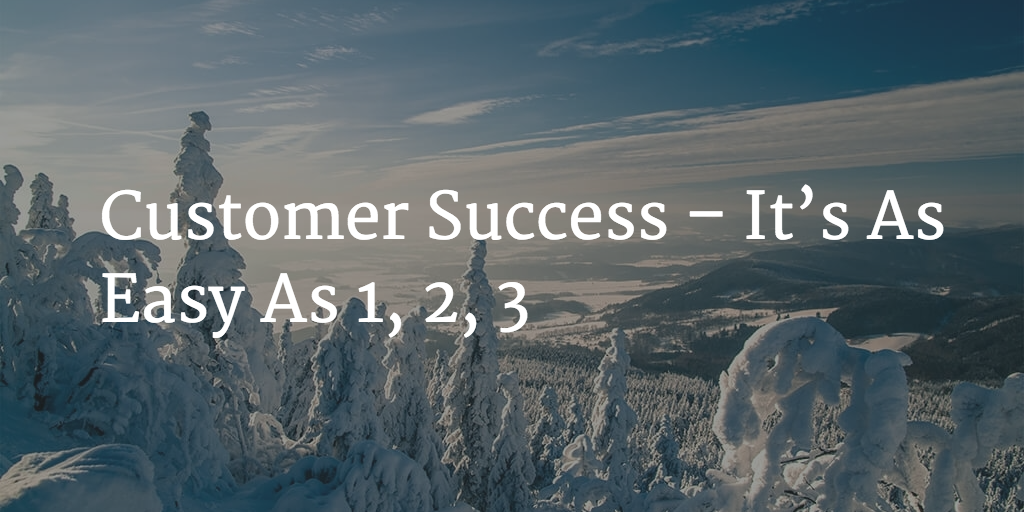We definitely live in a complex world. No argument there. But I think there are times when we over-complicate things. Customer Success is no different. It’s not simple to help customers get value out of our sophisticated products when they have 1000 other things to do, too. It’s no wonder we get paid so much money. But let’s take a few minutes to examine it from the top down and see if we can uncomplicate things just a bit.
One Main Customer Success Metric
Ultimately, there’s just one very “simple” measurement for a Customer Success team:
- Grow your install base
Am I right? Think about it. If a Customer Success team does its job well, won’t this be the result? Regardless of their actual responsibilities or activities, this should be the outcome of an effective team. One quick caveat – I realize that not all companies can actually grow their install base for a variety of reasons. I’m using the phrase “grow your install base” to cover both a) growth and b) improvement in your churn rate. Whether you are fighting to move the needle from 110% to 115% or from 92% to 96%, the idea is the same. In either case, growing your install base HAS to be the goal. The healthiest recurring revenue businesses are delivering 115% to 120% on their install base year over year.
I understand there are lots of factors at play in those numbers and that not every business has that capability. But, if some do and you don’t, no matter the reason, that’s not good for you. I realize that this measurement is macro. It’s akin to a Sales VP saying that his goal for the year is to increase bookings. Of course it is. But Customer Success hasn’t been around as long as Sales and some of these things are not so clear. I know of large Customer Success teams whose primary measurement of success is NPS score. I’m not saying that’s wrong. It may very well work for them. But I would claim that it’s ultimately just a proxy for growing their install base.
Two Key Customer Success Levers
There are only two levers to effect positive change on your book of business:
- Improve renewal rate
- Increase up-sell
Another way to sum up what Customer Success teams strive for is “happy, healthy customers”. And the last time I checked, happy, healthy customers do two things – 1) renew their contracts and 2) buy more product (or services) from you. Unfortunately, “happy” and “healthy” can be pretty subjective. Or, they used to be. As the Customer Success world gets more and more analytical and real solutions become available to those teams, objectively defining happy and healthy is much closer to a reality than it’s ever been before.
Now, many of you have heard me say before that, in an ideal world, I’d prefer to not have my CSMs selling. Am I contradicting myself by saying that the primary measurement of success and the levers to drive that measurement are both sales-focused? No. I’m not talking here about the activities of a Customer Success team, I’m talking about the measurement of success. A Customer Success team, and individual CSMs for that matter, should be measured on the growth of their book of business, accomplished by improving renewal rates and increasing up-sells, EVEN IF those CSMs don’t handle the renewals or close the up-sells. Check back at what happy and healthy customers do. And I don’t think it’s arguable that Customer Success is responsible for the “happy and healthy” part.
Three Customer Success Drivers
Now let’s dig one level deeper. We’ve got one measurement and two levers, and now three… drivers. There are three drivers of the two levers and the one measurement (and the partridge in a pear tree). They are:
- Product value
- Product adoption
- Customer experience
Customer Success teams have a significant, though obviously not exclusive, impact on each of these areas. Let’s examine them one at a time.
Product value – of the three, this is the most important. This is the one you would choose if you could only have one. This is the one that will allow you to survive, even if the other two don’t exist (within reason of course). Think about it in the extreme. If your product saved your customers a clear and provable $10M/day, that’s a product that will be extremely sticky even if there’s only one user and the overall customer experience is less than great. Reminds me a little of the Soup Nazi. Apparently the product had huge value. People stood in line down the block to pay their $3 for a bowl of mulligatawny despite the fact that the customer experience was anything but great. “No soup for you.” I hope you are in a business like that because it’s clearly the best.
Product value trumps <almost> all. That’s why every CSM in the world should have, as a part of their job responsibilities, these words – Field Product Management. In fact, I’ve claimed as the 10th law of “Dan’s Ten Laws of Customer Success”, that a CSM’s #1 priority is Product. Please note that I did NOT say “product adoption”. I said “Product”. We all know that no number of CSMs, no matter how skilled, can overcome a poor product. It just won’t happen. Customer Success needs to be one of the key influencers of an ever-improving product if you are to survive as a company. They understand what customers are doing, or are trying to do, with your product, and what really works and what doesn’t. Make sure there is a very purposeful, and regular, feedback loop between your CSMs and Product Management. If this is not happening today then change it. Today.
Product adoption – obviously, there’s a link between our three drivers. Product adoption will likely never happen if there’s not product value. And it will be stymied, if not completely thwarted, by a poor overall customer experience. However, product adoption can be accomplished if each of the others are kept at an acceptable level, and the Customer Success team should be exerting significant influence to move both of those beyond just acceptable. If you can successfully get your product adopted widely within your customer base, it can be almost as sticky as the high-value product discussed above. Salesforce is a great example here. I’d venture a guess that 90% of us have never had a conversation with a Salesforce CSM and yet the number of licenses at most of their customers literally grows every month.
There is obviously huge value in the Salesforce product. No $35B company ever existed that didn’t sell something of value. But is the stickiness driven by the value or by the widespread adoption? It’s clearly both, but I’d argue the latter is perhaps more important. In a scenario like that, stickiness exists largely because there’s a real cost to switching products and that cost goes up based on the number of users. Often this cost can’t easily be measured because it’s not the subscription and services dollars that have the biggest impact. It’s the cost of changing human behavior and processes, and retraining staff. It’s right for Customer Success teams to obsess about product adoption. It’s extremely important and a great way, if successful, to ensure high renewal rates. But remember, it’s priority #2, not #1 and it can’t be done if the product does not have ever-increasing value.
Customer experience – this one may go without explanation but let’s talk about it anyway. It’s certainly not the driver that can stand on it’s own, but it can certainly be a differentiator, especially if the others are not. Most companies live in a pretty competitive market where product differences are not as significant as they might think, and that means the customer experience is pretty important. In some industries, the customer experience can actually be a company’s distinguishing characteristic (think Nordstrom and Zappos). But in the software world, where most recurring revenue businesses live, it’s virtually impossible to distinguish yourself primarily through the customer experience. My advice here is simple – do this well and it will pay off. And it’s really not that hard to send out accurate invoices.
Or to meet reasonable SLAs on Customer Support. Or to do good handoffs between groups so your customers feel known no matter who they talk to. This is more about focus and passion than it is about money. And because it’s one of the three drivers of the two levers of the one measurement of Customer Success, the overall customer experience should be heavily influenced, if not directly owned, by the Customer Success team. Improving your customer’s experience with you has much more to do with passion and focus than it does intelligence and money. It’s just not that hard.
So, there you have it. As easy as 1, 2, 3. The next step after 1, 2, 3 is not 4. It’s “lots”. Lots of processes and activities and short-term measurements of success along the journey to growth. I’m not here to tell you what those should be, at least not in this post. You are all doing many of them every day already. I just wanted to refocus us on the high-level goals with which we need to align those activities.

